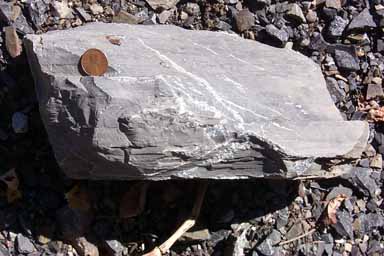|
LIMESTONE #1
Micrite Limestone Go on to: #1 | #2 | #3 | #4  Detail of this specimen
Detail of this specimen>>> Return to previous
Return to: Alphabetical Listing Basic Key Carbonate Key |
||
|
Composition
Micrite = lime mud; CaCO3, the mineral calcite. Micrite is the equivalent of clay (rock = shale) in clastics. Originally deposited as microscopic aragonite needles, but now converted to calcite and then calcite cemented to form the rock. See Origin of Micrite for more details.
|
Description
Dense, uniform, fine grained rock with conchoidal fracture. Faint, weak laminations running parallel to top of picture (see next to penny). The laminations are probably algal laminates, produced on tidal flats by colonies of blue-green algae.
|
|
|
Tectonic Association
Carbonates of all types are commonly associated with regions of tectonic stability and tropical climates, that is no mountain building, and stable, shallow water environments associated with continental shelves or epeiric (epicontinental) seas.Go to Carbonate Tectonics for more explanation. |
Formation & Environments
Micrite is one of the most common carbonate rocks. Most of what people call " limestone" is largely or exclusively micrite. As with clay (shale) it is deposited in generally quiet water, and appears in any environment where those conditions exist.Often we associate quiet water with deep water, where waves and currents do not touch bottom. But with carbonates that may not always be a good rule. Micrites (especially algal laminated micrites, as is this specimen) form readily in the upper regions of tidal flats (upper intertidal and supertidal), where periodic exposure to air is common. |
|